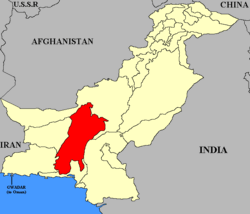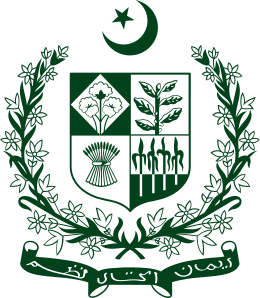Khanate of Kalat
| Kalat | |||||
| Subdivision Khanate within the Mughal Empire[1][2] and Durrani Empire,[3] Princely state of the British Raj and of Pakistan | |||||
| |||||
|
Flag | |||||
 | |||||
| Capital | Kalat | ||||
| History | |||||
| • | Established | 1666 | |||
| • | Disestablished | 14 October 1955 | |||
| Area | 91,909 km2 (35,486 sq mi) | ||||
| Today part of | Balochistan, Pakistan | ||||
| Government of Balochistan | |||||
.jpg)
 |
| This article is part of the series |
| Former administrative units of Pakistan |
|---|
|
Original provinces |
|
One-unit provinces |
|
Other subdivisions |
The Khanate of Kalat (Urdu and Balochi: خانیت قلات) was a princely state that existed from 1666 to 1955 in the centre of the modern-day province of Balochistan, Pakistan. Prior to that they were subjects of Mughal emperor Akbar.[1][2] Ahmedzai Baloch ruled the state independently until 1839, when it became a self-governing state in a subsidiary alliance with British India. After the signature of the Treaty of Mastung by the Khan of Kalat and the Baloch Sardars in 1876, Kalat became part of the Baluchistan Agency.[4] It was briefly independent from August 1947 till March 1948, when its khan acceded his state to the new Dominion of Pakistan. It remained a princely state of Pakistan until 1955, when it was incorporated into the country.
The state capital was the town of Kalat. The current Khan of Kalat is a ceremonial title held by Mir Suleman Dawood Jan, and efforts have been made by the Pakistani government to reconcile with him, his son Prince Mohammed, who is next in line to be the Khan of Kalat is pro-Pakistan.[5]
Geography
The Khanate of Kalat occupied the central part of the territory of modern-day Balochistan province in Pakistan. To the north was Baluchistan (Chief Commissioner's Province).
The principal mountains are the Central Baloch, Kirthar, Pab, Siahan, Central Makran and Makran Coast Ranges, which descend in elevation from about 10,000 to 1,200 feet (370 m). The drainage of the country is almost all carried off to the south by the Nari, Mula, Hab, Porali, Hingol and Dasht rivers. The only large river draining northwards is the Rakhshan. The coast line includes Gawadar, Pasni, Sonmiani and Geewani, modern-day Pakistani Balochistan.
Subdivisions
The Khanate of Kalat included the Makran, Jhalawan, Kacchi and Sarawan administrative divisions, as well as the two feudatory states of Las Bela and Kharan
History
The Khanate of Kalat was founded in 1666 by Mir Ahmad Khan Qambrani Baloch. The Khanate reached at its peak during the period of Khan of Kalat Mir Naseer Khan Noori Ahmadzai Baloch I in 1758, who unified Kalat region under his flag.[6] The territories controlled by the state fluctuated over the centuries but eventually were established by treaties with the British Agent Robert Sandeman in the late 19th century. Parts of the state to the north and northeast were leased or ceded to form the province of British Baluchistan which later gained the status of a Chief Commissioners province.
From 15 August 1947 to 27 March 1948, the region was de facto independent before acceding to Pakistan on 27 March 1948. The Baluchistan States Union was formed on 3 October 1952 with three neighbouring states. The Khanate of Kalat ceased to exist on 14 October 1955 when the province of West Pakistan was formed.
Rulers of Kalat
The rulers of Kalat held the title of Wali originally but in 1739 also took the title (Begler Begi) Khan usually shortened to Khan. The last Khan of Kalat (Urdu and Balochi: خان قلات) had the privilege of being the President of the Council of Rulers for the Baluchistan States Union.
| Tenure | Khan of Kalat [6] |
|---|---|
| 1512-1530 | Mir Bijar Khan Mirwani Baloch |
| 1530-1535 | Mir Zagar Khan Mirwani Baloch |
| 1535-1547 | Mir Ibrahim Khan Qambrani Baloch ( Changed his Royal family name from Mirwani to Qambrani ) |
| 1547-1549 | Mir Gwahram Khan Qambrani Baloch |
| 1549-1569 | Mir Hassan Khan Qambrani Baloch |
| 1569-1581 | Mir Sanjar Khan Qambrani Baloch |
| 1581-1590 | Mir Malook Khan Qambrani Baloch |
| 1590-1601 | Mir Qambar Sani Khan Qambrani Baloch |
| 1601-1610 | Mir Ahmad Khan Qambrani Baloch I |
| 1610-1618 | Mir Suri Khan Qambrani Baloch |
| 1618-1629 | Mir Qaisar Khan Qambrani Baloch |
| 1629-1637 | Mir Ahmad Sani Khan Qambrani Baloch II |
| 1637-1647 | Mir Altaz Khan Qambrani Baloch I |
| 1647-1656 | Mir Kachi Khan Qambrani Baloch |
| 1656-1666 | Mir Altaz Sani Khan Qambrani Baloch II |
| 1666–1695 | Mir Ahmad I Khan Qambrani Baloch III ( Changed his Royal family name from Qambrani to Ahmadzai ) |
| 1695–1697 | Mir Mehrab Khan Ahmadzai Baloch I |
| 1697–1714 | Mir Samandar Khan Ahmadzai Baloch ( Amir al-Umara Amir of Amirs) |
| 1714–1716 | Mir Ahmad II Khan Ahmadzai Baloch |
| 1716–1731 | Mir Abdullah Khan Ahmadzai Baloch ( Eagle of the Mountain and The Greatest ) |
| 1731–1749 | Mir Muhabbat Khan Ahmadzai Baloch ( Beglar Begi ) |
| 1749–1794 | Mir Muhammad Nasir Khan I Ahmadzai Baloch ( Noori, Ghazi, Wali and The Great ) |
| 1794–1817 | Mir Mahmud Khan I Ahmadzai Baloch |
| 1817 - 13 November 1839 | Mir Mehrab Khan Ahmadzai Baloch II |
| 1839–1841 | Mir Shah Nawaz Khan Ahmadzai Baloch |
| 1841–1857 | Mir Nasir Khan II Ahmadzai Baloch |
| 1857 - March 1863 | Mir Khudadad Khan Ahmadzai Baloch (1st time); during his rule, there were seven major and many minor rebellions. |
| March 1863 - May 1864 | Mir Sherdil Khan Ahmadzai Baloch (usurped throne) |
| May 1864 - 15 August 1893 | Mir Khudadad Khan (2nd time) |
| 10 November 1893 – 3 November 1931 | Mir Mahmud Khan II Ahmadzai Baloch |
| 3 November 1931 – 10 September 1933 | Mir Mohammad Azam Jan Khan Ahmadzai Baloch |
| 10 September 1933 – 14 October 1955 | Mir Ahmad Yar Khan Ahmadzai Baloch (1st time); declared independent on 5 August 1947; compelled to accede to Pakistan on 30 March 1948[7] |
| 14 October 1955 | State of Kalat meged into One Unit of West Pakistan[8] |
| 20 June 1958–1958 | Mir Ahmad Yar Khan Ahmadzai Baloch (2nd time) |
See also
_(14782070024).jpg)
- Baluchistan (Chief Commissioner's Province)
- Makran
- Las Bela (princely state)
- Kharan (princely state)
- Kalat State National Party
- Balochistan region
- List of Indian Princely States
References
- 1 2 Treaty of Kalat between Balochistan and Afghanistan in 1758
- 1 2 "Baluchistan" Imperial Gazetteer of India Vol. 6, p. 277, from the Digital South Asia Library, accessed 15 January 2009
- ↑ http://thebaluch.com/documents/Nasir%20Khan%20Noori.pdf
- ↑ Balochistan Archives - Records of the Agent to the Governor General in Balochistan
- ↑ http://www.dawn.com/news/1191121
- 1 2 Naseer Dashti (8 October 2012). The Baloch and Balochistan: A Historical Account from the Beginning to the Fall of the Baloch State. Trafford Publishing. p. 280. ISBN 978-1-4669-5897-5. Retrieved 6 August 2013.
- ↑ Siddiqi, Farhan Hanif (2012), The Politics of Ethnicity in Pakistan: The Baloch, Sindhi and Mohajir Ethnic Movements, Routledge, pp. 59–60, ISBN 978-0-415-68614-3
- ↑ Siddiqi, Farhan Hanif (2012), The Politics of Ethnicity in Pakistan: The Baloch, Sindhi and Mohajir Ethnic Movements, Routledge, p. 62, ISBN 978-0-415-68614-3
Further reading
- Siddiqi, Farhan Hanif (2012), The Politics of Ethnicity in Pakistan: The Baloch, Sindhi and Mohajir Ethnic Movements, Routledge, ISBN 978-0-415-68614-3
External links
- Swidler, N. (1972) "The Development of the Kalat Khanate" Journal of Asian and African Studies 7: pp. 115–21
- Swidler, N. (1992). Kalat: The Political Economy of a Tribal Chiefdom. American Ethnologist, 19(3), 553-570
- Kalat District - Planning and Development Department of Balochistan Government
- Genealogy of the Khans of Kalat
Coordinates: 29°01′33″N 66°35′24″E / 29.02583°N 66.59000°E
